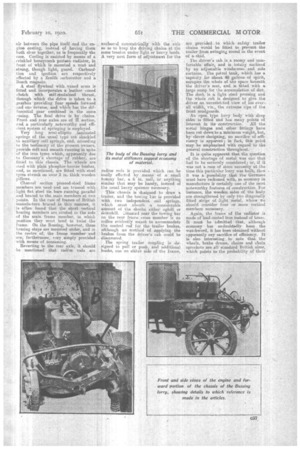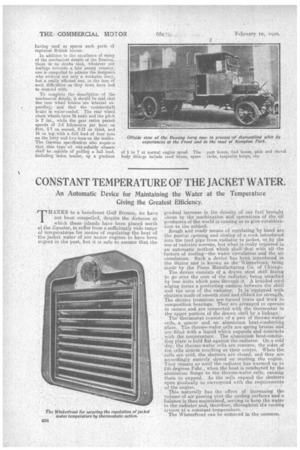THE BUSSING TRANSPORT LORRY.
Page 20

Page 21

Page 22

If you've noticed an error in this article please click here to report it so we can fix it.
A Review of the Many Interesting and Clever Points on a Captured German War-subsidy Chassis.
1 T HAS RECENTLY been our good
fortune to examine Lila take notes of s, captured German lorry, and after the incidents of the past six years the results, of our inspection lia,ve been _so interesting that, although the vehicle is of enemy origin, we make no apology in publishing particulars which we think should be of equal interest and value to British designers, as a reminder of German methods.
The Bussing is probably one of the best of the chassis_ emanating from the land of our former enemies, and the particular one under notice has a history which undoubtedly speaks well for its capabilities. As regards the historical particulars which we are able to give, we are not able to vouch for them as being first-hand information, although we have good reason to believe them tci be true; thio meciharridat details: 'are, however, as actually noted by ourselves during our inspection. z • The ',credit for the capture of this lorry belongs to the 2nd Canadian Divi sion, who took it, together' with several' others of different makeS, at Vimy Ridge, during the advance in September', ,1918, be acquainted. From , this dump the
Bussing was transferred to•Poullens thence to Abbeville, on to Bonen,. and finally to Le Havi,e, Where it was em
., .„
barked for England, Its port of a•rrival in England was Portsniouth, whence it 5155 Sent to kernpton. • Park (judging • frkirii its'appearance it suffered more froM is stay here than from all its War' • service); arid again on to Shepherd's Bush,' and lastly to Birmingham, where at, one-of the Government auction sales • at Biniley :Hall. it was sold under the banimer for' the sum. of 35 'guineas! The pmechaserS were a well-known firm of transport contractors, at'whose .works it is now being overhauled and carefully sttidied froni the point of view Of de
• sign. According to records, this lorry covered 11,000 miles on actual war .service up to the date of its capture, and was only in the workshops for Minor . repairs on two occasions. At the pre, sent time it is in the condition in which it was purchased, and, except for a fp* 'minor detail i
s, the engine is n first-claas condition, whilst rearwards from the flywheel everything is in good order. The bodywork and metal panelling are in very fair condition, except for a few small holes and indentations due to shellfire whilst, in action just prior to its capture, but, these items are of such small importance as to he practically negligible,no part of importance having been hit.
So far, the chassis has not been cOnipletely dismantled, so that we cannot, -unfortunately,give many of the, details that would be of interest to British manufacturers, such as the weights of the reciprocating parts of the engine, tbe asses of the bearings., etc., but we can, thanks to access to a printed specification of the German' Government's requireinents of these lorries, enumerate many Outstanding features.
.. The engine is a four-cylinclered Hausa Lloyd of Hamburg, and has its cylinders, of 130 rum. bore and 150 mpri
stroke, cast " en blue." It is A governed engine with exceptionally large Inlet and exhaust valves situated side by side and is rated 'at 35-65 h.p: All that we are able to say about the internal parts of the engine at preseqt is that the crankshaft is of Krupp manufacture, and that a half-compression devil* is used, the control of which is by a pull-rod situated convenient to the driver's hand when cranking. The lobxieating oil is. circulated by a pump, is also the water, and.`-it is noticeable in the latter ease that thought has been given to the accessibility of all water pipes. Another noteworthy feature of the exterior fittings of the engine concerns the exhaust manifold, which is so designed as to allow a free passage of
air between the pipe itself And the engine casting, instead of having them both close together, as ie frequently the ease. 'Cooling is assisted by means of a crinkled honeycomb pattern radiator, in front of which is mounted a neat and strong, though light, guard. Carbura'tion and ignition am o respectively effected by e Zenith carburetter and a Bosch magneto.
A. steel flywheel with vaned arms is fitted and ineorperates a leather coned clutch with rielf -ciontained thrust, through which the drive is taken to a gearbox providing four speeds forward and one reverse, and which_ has the differential gear combined 'in the satne easing. The final drive is by chains. Front and rear axles are of H section, and, a particularly noteworthy and efficient system of springing is employed.
Very long semi-elliptic laminated springs of the. usual type Are shackled to auxiliary (soil springs, and, according to the testimony of the present owners, previde soft and smooth running in spite of the iron tyres which, arparently due to Germany's shortage of rubber, are fitted to this chassis. The wheels are ,steel with plain phosphor-bronze bushes, and, as mentioned, are fitted with steel tyres shrunk on over 2 in. thick wooden Channel section pressed-steel frame members are used and are trussed with • light flat Steel tie bars running parallel and braced to the main members at two points: In the case f frames of British manufacture braced in this manner, it is often found that the short vertical bracing members arc riveted to the side of the main frame member, in which position they must tend to twist the frame. On the Bussiug, however, these bracing stays are mounted under, and in the centre of, the frame member and are, furthermore. very, .simply provided with means of tensioning.
Reverting to the,rear axle, it should be mentioned that rarctins rods are anchored Iconoentrically with the axle so as to keep the driving chains at the same tension under light or heavy loads. A very neat form of adjustmeet for the
radius rods is provided which can be easily effected by means of a serail tonality bar, a 6 in. nail,. or anything similar that may be handy, instead of the usual heavy spanner necessary.
This ehaseis is designed to draw a trailer, and the towing bar is 'provided with two'independent coil springs, which must absorb a considerable amount of the shocks either uphill or downhill. liituated near the towing bar on the rear frame cross member is an orifice evidently meant to accommodate the control rod for the trailer brakes, although net nvetliod of Applying the brakes from the driver's cab could be discovered. .
The spring trailer coupling is designed to pull or push, and additional hooks, one on either side of the frame,
are provided'. to which safety trailer chains would be fitted to peevent the trailer frem swinging round in the event of a•skid.
The driver's cab is a reemyand reinforiable affair, and is totally enclosed by an adjustable windscreen and side curtains. The petrol tank, Which has a capacity ior about 90 gallons Of
occupies the whole of the space beneath the driver's seat, and is fitted with a large sump for the accumulation of dirt. The dash is a light steel pressing and the whole cab is designed to give the driver an unrestricted view of hisoverall width, viz., the extreme tips of the front mudguards.
An open type lorry body with drop sides is fitted and has many points of interest in its construction. All the metal hinges and other fittings have been cut down to a minimum weight, but, by clever designing, no sacrifice of .efficiency is apparent; in fact, this point may be emphasized with regard to the general construction throughout. ,
It is quite apparent that the question of the shortage of metal was ono that had to be sericeisly considered; or, if it was not a case of stern necessity at the time this particular lorry was built, then it was a. possibility' thatthe Germans must have reckoned with, as economy in manufacture is certainly one of the most noteworthy features' ofconstruction. For instance the wooden, sides of the body are strengthened by only two diagonally fitted strips of..light metal, where we should consider four ' or more vertical
members necessary.
Again, the frame of the radiator is made of lead-Coatocl iron instead of brass. It must be admitted, that, although economy has undoubtedly been the watelyword, it has been obtained without apparently any sacrifice of efficiency. it is also interesting to note that, the wheels, brake drums, chains and chain sprockets are all standard British sizes, which points to the probability of their having used as spares such parts of captured British lorries.
In addition to the excellence of many of the mechanical details of the Bussing, there is no doubt that, whatever our feelings _towards a late enemy country, one is compiled to admire the designers who evolved not Only a Workable lorry; but a really efficient one, in the: face of such difficulties as they must have had
to contend with. •
To complete the description of the mechanical details, it should be said that the rear Wheel. brakes -ate interim! ex.pending,. and that the countershaft brake is water-cooled: The rear wheel chain wheels h,ave 36 teeth and the pitch is 2 ins, while the gear ratios permit speech of 3-4 kilometres per hour on first, 5-7 on second,' 9-13 on 'third, and 16 on top with a full load of four tons on the lorry and two tons on the trailer. The German specifbeatian also requires that this type of whr-subsidy 'chassis shall be capable of pulling a full load, including 'laden trailer, up a gradient






























